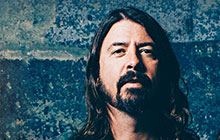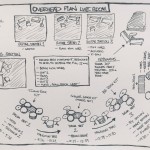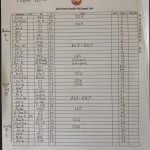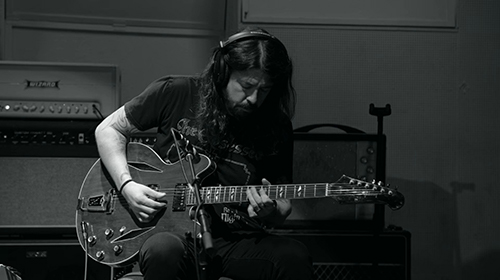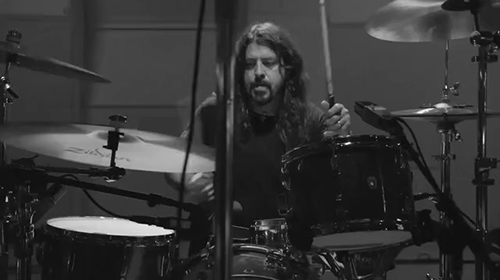Session Information
As guitarist Chris Shiflett had noted when discussing how the band was going to record their Sonic Highways album, Dave Grohl always has many ideas rattling around his head at any given moment. Some of them a little crazy, some more orthodox.
In late 2017 one of the crazier ideas sprung into Grohl’s mind. Ever since the late 1980s, Grohl had been recording his own music and had a special talent of being able to record an entire song himself, playing every instrument and singing vocals for a complete take. It was a technique he’d first developed as a youngster, utilizing two cassette recorders in his bedroom to build up a song with multiple instruments.
Of course, being just one man, he could only ever do that in a one-by-one process – usually drums first, then bass, guitar, and finally vocals. For this new audio-visual production, Grohl planned to change that limitation by cloning himself. Kind of.
The core part of the idea was to record a 23-minute instrumental piece of music he’d written over the course of ten days using old unused riffs and unfinished song ideas, as well as some new ideas. Laying out all the instruments in a recording studio, each would be recorded live in one take. Then would come the magic part. Using special video editing techniques, the finished product would blend all of the performances together into one video, giving the effect of five clones helping the original Dave Grohl to record the song in one harmonious take.
For Grohl, this was not just a vanity project to show off his recording skills. It was instead intended to serve as an inspiration for young children interested in playing music. He wanted to show “the rewards and challenges of dedicating one’s life to playing and mastering a musical instrument,” having been inspired by his own children going through that process just as he had. “Watching my kids start to play music and learn to sing or play drums, it brings me back to the time when I was their age listening to albums, learning from listening… and when I take my kids to the place where they take their lessons, I see these rooms full of children that are really pushing themselves to figure this out,” Grohl said.
To carry out the project he once again returned to EastWest Studios in Hollywood in March 2018, almost a year to the day after initial recording for the album ‘Concrete And Gold’ had been completed there.
Grohl worked on musical production of the session himself although Darrell Thorp was again on hand to engineer, assisted by Tyler Shields and Sydney Matsumoto. On the video side of things, Grohl was also in charge alongside Mark Monroe, who he’d worked with on both the Sound City and Sonic Highways video projects. Therapy? Content also collaborated on the project, again returning from previous Grohl videos.
As he’d always done before, Grohl started with the drums. Whilst he would record the 23-minute track in one take, he did not do so on just one drum kit, deciding that certain parts of the music called for a different kit. His laser blue Drum Workshop Jazz Series kit was used for the first ten minutes of the track, which featured heavy, up-tempo beats. Alongside the first full kit, Grohl had set up what he considered a transition kit, consisting of just a single floor tom and two cymbals, to enable him to move to the second full kit without ever completely stopping.
The second set of drums was, in fact, a smaller Ludwig kit he’d bought for his daughter Harper to learn on, deciding it was perfect for the softer, slower-paced section of the instrumental - what he’d himself dubbed as a “mellow groove”. Another transition station then allowed him to switch to the final kit for the remaining six or so minutes of the song. Dubbed the “big rock kit”, it was actually the same Slingerland set that had been used for the One By One and In Your Honor album. The kit featured a large kick drum with two sound holes for microphones and was used for a section of the track in 3/4 time, followed by another heavy section, a ‘dirge’ section, and the big crescendo finale.
Grohl was serious about recording the music in one take, going right back to the start whenever he made a mistake. Once the first complete take was completed, he didn’t start splicing in newer takes to create one perfect take, he went back out into Studio 1 and started over, repeating this until he was happy with one complete recording of his drum track.
Drums completed, he headed out of the performance room, changed into a new set of clothes for the purposes of appearing as a different Dave Grohl clone and started with the first guitar track. Guitar station one was set up with a black 1957 Gretsch Duo Jet, a guitar he’d been using since recording the third Foo Fighters album There Is Nothing Left To Lose in 1999. With this he could record some of the slightly deeper tones, using a relatively clean signal.
With one guitar track laid down as a guide, Grohl then switched clothes again to record Bass guitar, using a Fender P-Bass Elite model.
After another change of clothes, he then came to the second guitar track recorded with a 1967 black Gibson Trini Lopez with a Bigsby Whammy Bar. With these he played a mixture of distorted leads and cleaner parts, utilizing several effects pedals to do so.
At the final guitar station were two guitars, his favorite red Gibson Trini Lopez and a maple bodied Gibson Dove acoustic guitar. The latter was used for the mellow sections six minutes into the track with the Trini Lopez filling out the big rock sound in the rest of the song. An E-Bow was also on hand at the third guitar station which Grohl used with the Trini Lopez for a very brief part of the ‘dirge’ section of the track.
With the core elements of the track laid down, he then moved on to his weakest instrument, keyboards. Grohl sat surrounded by several different models, utilizing four in the final take – a Yamaha DX7 synthesizer, a Nord Wave Synthesiser, a Rhodes Piano, and a Wurlitzer Electric Piano. With playback of the track in his headphones, Grohl bounced between the four, each offering a different sound for each part of the track. The Rhodes was used for the clean piano whilst the DX7 gave Grohl some funkier, distorted sounds.
Finally, the finishing touches were added with some percussion. A Yamaha Xylophone, tambourines, plastic Cowbell, Timpani drums, and wooden shaker were all used during the lengthy track.
The final product was completed in seven days with seven different Dave Grohl’s involved. One drum track, three guitar tracks, a bass track, percussion, and keys.
When Grohl initially discussed the project with the music press before recording he teased that he might not even release it, just doing it for his own amusement. That statement was something of a tease, as barring any disasters Grohl had always planned to release the project and attempt to build on it, supporting workshops around the world in helping youngsters learn the trade.
The project, entitled ‘PLAY’, was first revealed to the public in August 2018 with a website set up allowing fans to watch the spliced video of the completed recording featuring Dave and his six clones. Fans were also given the ability to isolate the camera feeds and watch an entire take of each of the seven tracks, from start to finish. A special 12-inch Vinyl edition of PLAY was released in September.
